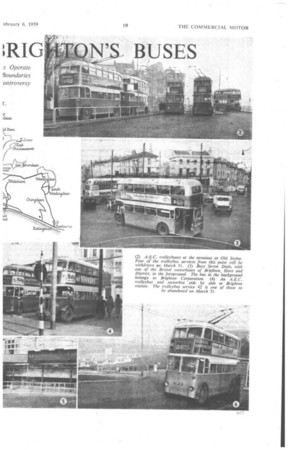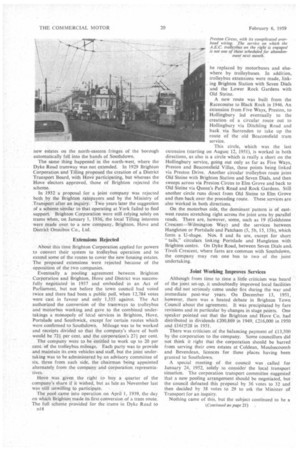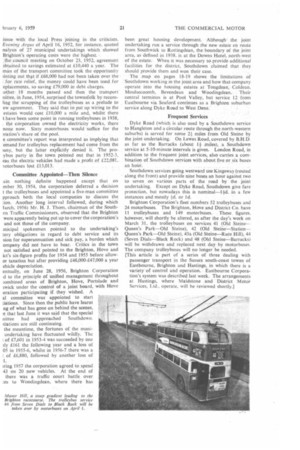BUSES
Page 59

Page 58

Page 60

Page 63

If you've noticed an error in this article please click here to report it so we can fix it.
TRANSPORT in Brighton has been a perennial subject of discussion for 'many years, largely because of the local-government boundaries and the differing attitudes of contiguous authorities in the past. Travelling in the district, it is impossible to tell casually where Brighton, Hove, Portslade and Southwick begin or end.
In Victorian times none of these places stretched far inland, and they were adequately served by the railways and by horsed-buses. Nearly all the horsed-bus owners joined together in 1884 to 'form the Brighton, Hove and Preston United Omnibus Co.; Ltd., who made Conway Street, Hove, the site of their headquarters. A horsed tramway ran between Hove and Shoreham from 1882 until 1913, but, although it came under B.E.T. control in 1898. it was never electrified.
Brighton Corporation started operating electric trams in 1901, but these were employed on routes running inland and; fanning out from Victoria Gardens, did not greatly interfere with the horsed-buses. The Brighton, Hove and Preston. Co. experimented with motorbuses at an early date and in 1911 obtained trolleybus powers. These, however, were never exercised, as Brighton and Hove Corporations obtained powers for both trolleybuses and motorbuses in 1912 and made provision for the joint operation of the main east-west route.
Compensation for Loss of Powers
Brighton Corporation paid the company compensation for the surrender of their trolleybus powers. Neither corporation, however, did anything at that time beyond putting up some experimental lengths of wiring for demonstration vehicles.
For some years before 1912, Worthing Motor Services. Ltd., had been running into Brighton from Worthing, but in that year they withdrew by agreement with the Brighton, Hove and Preston Co. to concentrate on the country districts.
Difficulties occasioned by the outbreak of war in 1914 led to the formation of Southdown Motor Services, Ltd., who stook over the Worthing • company's routes and vehicles, those of the London and Southern Counties Haulage Co. (running to Lewes and Hurstpierpoint) and the country Services and some buses of the Brighton, Hove
and Preston Co.agreement was made that Southdown (who became a 1.E.T. associate) should not compete with B.H. and P. in .a defined area, roughly Brighton and Hove. What really put the cat among the pigeons was the appearance of Thomas Tilling, Ltd., • in 1915, when they secured' liccnces in HoVe but not -in Brighton, a difficulty overcomeby running. etpressinto7Brighton. at return fares.
016 The competition was particularly serious for B.H. and P., who had lost their newest buses to the Army, and the struggle ended in Tilling buying the local concern on November 22, 1916. It is particularly noteworthy that Tilling voluntarily paid contributions to Brighton and Hove Corporations for road maintenance from 1919 to 1932.
Brighton Corporation failed to extend their tramway system to keep pace with housing developments. Even when they secured powers in 1920 for an extension along Lewes Road to Moulsecoomb, nothing was done, so that the new estates on the north-eastern fringes of the borough automatically fell into the hands of Southdown.
The same thing happened in the north-west, where the Dyke Road tramway was not extended. In 1929 Brighton Corporation and Tilling proposed the creation of a District Transport Board, with Hove participating, but whereas the Hove electors approved, those of Brighton rejected the scheme.
In 1932 a proposal for a joint company was rejected both by the Brighton ratepayers and by the Ministry of .Transport after an inquiry. Two years later the suggestion of a scheme similar to that operating at York failed to find support. Brighton Corporation were still relying solely on trams when, on January 1, 1936, the local Tilling interests were made over to a new company, Brighton, Hove and District Omnibus Co., Ltd.
Extensions Rejected
About this time Brighton Corporation applied for powers to convert their system to trolleybus operation and to extend some of the routes to cover the new housing estates. The proposed extensions were rejected because of the opposition of the two companies.
Eventually a pooling agreement between Brighton Corporation and Brighton, Hove and District was successfully negotiated in 1937 and embodied in an Act of Parliament, but not before the town council had voted twice and there had been a public poll, when 12,784 votes were cast in favour and only 1,355 against. The Act authorized the conversion of the tramways to trolleybus and motorbus working and gave to the combined undertakings a monopoly of local services in Brighton, Hove, Portslade and Southwick, except for certain routes which were confirmed to Southdown. Mileage was to be worked and receipts divided so that the company's share of both would be 721 per cent. and the corporation's 274per cent.
The company were to be entitled to work up to 20 per cent, of the trolleybus mileage. Each party was to provide and maintain its own vehicles and staff, but the joint undertaking was to be administered by an advisory committee of six, three from each side, the chairman being appointed alternately from the company and corporation representatives.
Hove was given the right to buy a quarter of the company's share if it wished, but as late as November last was still unwilling to participate.
The pool came into operation on April 1, 1939, the day. en which Brighton made its first conversion of a tram route. The full scheme provided for the trams in Dyke Road to
DI8 be replaced by motorbuses and elsewhere by trolleybuses. In addition, trolleybus extensions were made, linking Brighton Station with Seven Dials and the Lower Rock Gardens with Old Steine.
A new route was built from the Racecourse to Black Rock in 1946. An extension from Five Ways, Preston, to Hollingbury led eventually to the creation of a circular route out to Hollingbury via Ditchling Road and back via Surrenden to take up the route of the old Beaconsfield tram service.
This circle, which was the last extension (starting on August 12, 1951), is worked in both directions, as also is a circle which is really a short on the Hollingbury service, going out only as far as Five Ways, Preston and Beaconsfield Villas, these points being linked via Preston Drive. Another circular trolleybus route joins Old Steine with Brighton Station and Seven Dials, and then sweeps across via Preston Circus to Elm Grove and back to Old Steine via Queen's Park Road and Rock Gardens. Still another circle runs direct from Old Steine to Elm Grove and then back over the preceding route. These services are also worked in both directions.
On the motorbus side, the dominant pattern is of eastwest routes stretching right across the joint area by parallel roads. There are, however, some, such as 19 (Goldstone Crescent—Wilmington Way) and the services between Hangleton or Portslade and Patcham (5, 5b, 15, 15b), which form a U-shape. Nos. 8 and 8a are, except for short "tails," circulars linking Portslade and Hangleton with Brighton centre. On Dyke Road, between Seven Dials and Tivoli Crescent, where fares are common with Southdown, the company may run one bus to two of the joint undertaking.
Joint Working Improves Services
Although from time to time a little criticism was heard of the joint set-up, it undoubtedly improved local facilities and did not seriously come under fire during the war and immediate post-war years. On December 13, 1951, however, there was a heated debate in Brighton Town Council about the agreement. It was precipitated by fare revisions and in particular by changes in stage points. One speaker pointed out that the Brighton and Hove Co. had distributed in dividends £200,869 in 1949, £216,000 in 1950 and £161528 in 1951.
There was criticism of the balancing payment of £13,500 by the corporation to the company. Some councillors did not think it right that the corporation should be barred from serving their own estates at Coldean, Moulsecoomb and Bevendean, licences for these places having been granted to Southdown.
A special meeting of the council was called for January 24. 1952, solely to considerthe local transport situation. The corporation transport committee suggested that a new pooling arrangement should be negotiated, but the council defeated this proposal by 36 votes to 32 and then decided by 38 votes to 29 to ask the Minister of Transport for an inquiry.
Nothing came of this, but the subject continued to be a (Continued on page 21) issue with the local Press joining in the criticism. Evening Argus of April 16, 1952, for instance, quoted nalysis of 27 municipal undertakings which showed Brighton's operating costs were the highest. ,
the council meeting on October 23, 1952,• agreement )btained to savings estimated at £10,440 a year. The man of the transport committee took the opportunity tinting out that if £68,000 had not been taken over the for rate relief, the money could have been used for 'eplaeements, so saving £79,000 in debt charges.
Lother • 18 months passed and then the transport nittee, in June, 1954, surprised the townsfolk by recomling the scrapping of the trolleybuses as a prelude to ew agreement. They said that to put up wiring to the estates would cost £10,000 a mile and, whilst there t have been some point in running trolleybuses in 1938, . the corporation owned the electricity works, there none now. Sixty motorbuses would 'suffice for the nation's share of the pool.
e committee's report was interpreted as implying that emand for trolleybus replacement had come from the lany, but the latter expricitly denied it. The proybus party in the town pointed out that in 1952-3, eas the electric vehicles had made a profit of £22,081. totorbuses lost £13,013.
Committee Appointed—Then Silence
am n nothing definite happened except that on mber 30, 1954, the corporation deferred a decision t the trolleybuses and appointed a five-man committee pproach both the local companies to discuss the ;ion. Another long interval followed, during which larch, 1956) Mr, H. J. Thom, chairman of the Southrn Traffic Commissioners, observed that the Brighton were apparently being put up to cover the corporation's and not those of the company.
Jnicipal spokesmen pointed to the undertaking's tory obligations in regard to debt service and its sion for superannuation and sick pay, a burden which ompany did not have to bear. Critics in the town not satisfied and pointed to the Brighton, Hove and ices six-figure profits for 1954 and 1955 before allowor taxation but after providing £46,000-£47,000 a year chide depredation. entually, on June 28, 1956, Brighton Corporation d to the principle of unified management throughout ;ombined areas of Brighton, Hove, Portslade and twick under the control of a joint board, with Hove oration participating if they wished. A al committee was appointed to start ;iations. Since then the public have learnt ng of what has gone on behind the scenes, A that last June it was said that the special nittee had approached Southdown.
■ tiations are still continuing.
the meantime, the fortunes of the muniundertaking have fluctuated wildly. The of £7,601 in 1953-4 was succeeded by one ily £161 the following year and a loss of 05 in 1955-6, whilst in 1956-7 there was a ; of £6,880, followed by another loss of
1.
wing 1957 the corporation agreed to spend
43 on 20 new vehicles. At the end of there was a traffic court battle over :es to Wooclingdean, where there has
been great housing development. Although the joint undertaking run a service through the new estate en route from Southwick to Rottingdean, the boundary of the joint area, as defined in 1938, is at the Downs Hotel, north-west of the estate. When it was necessary to.provide additional facilities for the district, Southdown claimed that they should provide them and won their case.
The map on pages 18-19 shows the limitations of Southdown working in the joint area and how that company operate into the housing estates at Tongdead, Coldean, Moulsecoomb, Bevendean and Wooclingdean.. Their central terminus is at Pool Valley, but service. 12 from Eastbourne via Seaford continues as a Brighton suburban service along Dyke Road to West Dene.
Frequent Services
Dyke Road (which is also used by a Southdown service to Hangleton and a circular.route through the north-western suburbs) is served for some 21 miles from Old Steine by the joint undertaking. On Lewes Road, covered by B.H.D. as far as the Barracks (about 1 miles), a Southdown service at 5-10-minute intervals is given. London Road, in addition to the frequent joint services, also carries a combination of Southdown services with about five or _six buses an hour'.
Southdown services going westward use Kingsway (routed along the front) and provide nine buses an hour against two to seven on various parts of the road by the joint undertaking. Except on Dyke Road, Southdown give fare protection, hut nowadays this is nomina1-11d. in a few instances and mostly id. or Id.
Brighton Corporation's fleet numbers 52 trolleybuses and 24 motorbuses. The Brighton, Hove and District Co. have 11 trolleybuses and 149 motorbuses. These. figures. however, will shortly be altered, as after the day's work on March 31, the trolleybuses on services 41 (Old SteineQueen's Park—Old Steine), 42 (Old Steine—StationQueen's Park—Old Steine), 43a (Old Steine—Race Hill), 44 (Seven Dials—Black Rock) and 48 (Old Steine—Barracks) will be withdrawn and replaced next day by motorbuses. The company trolleybuses will no longer be needed.
[This article is part of a series of three dealing with passenger transport in the Sussex south-coast towns of Eastbourne, Brighton and Hastings, in which there is a variety of control and operation. Eastbourne Corporation's system was described last week. The arrangements at Hastings, where Maidstone and District Motor Services, Ltd., operate, will be reviewed shortly.]




























































































































